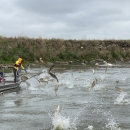Species that are considered uncertain risk need a more in-depth assessment beyond the Risk Summary to better define the species’ risk to U.S. environments.
It is not entirely clear whether R. cuneata is a native species along the east coast of the United States (see Remarks under section 1) which renders its status as an invasive species invasive species
An invasive species is any plant or animal that has spread or been introduced into a new area where they are, or could, cause harm to the environment, economy, or human, animal, or plant health. Their unwelcome presence can destroy ecosystems and cost millions of dollars.
Learn more about invasive species along the east coast uncertain as well. Although one report of bio-fouling in Delaware does exist, it occurred over 30 years ago. If the species isn’t native to the east coast and is indeed an invasive species, one can’t help but wonder why this species has not become more of a problem since it was first reported in the 1960’s. Despite a high climate match in the United States, questions on the native range of R. cuneata and its invasiveness cause this assessment to be uncertain.



